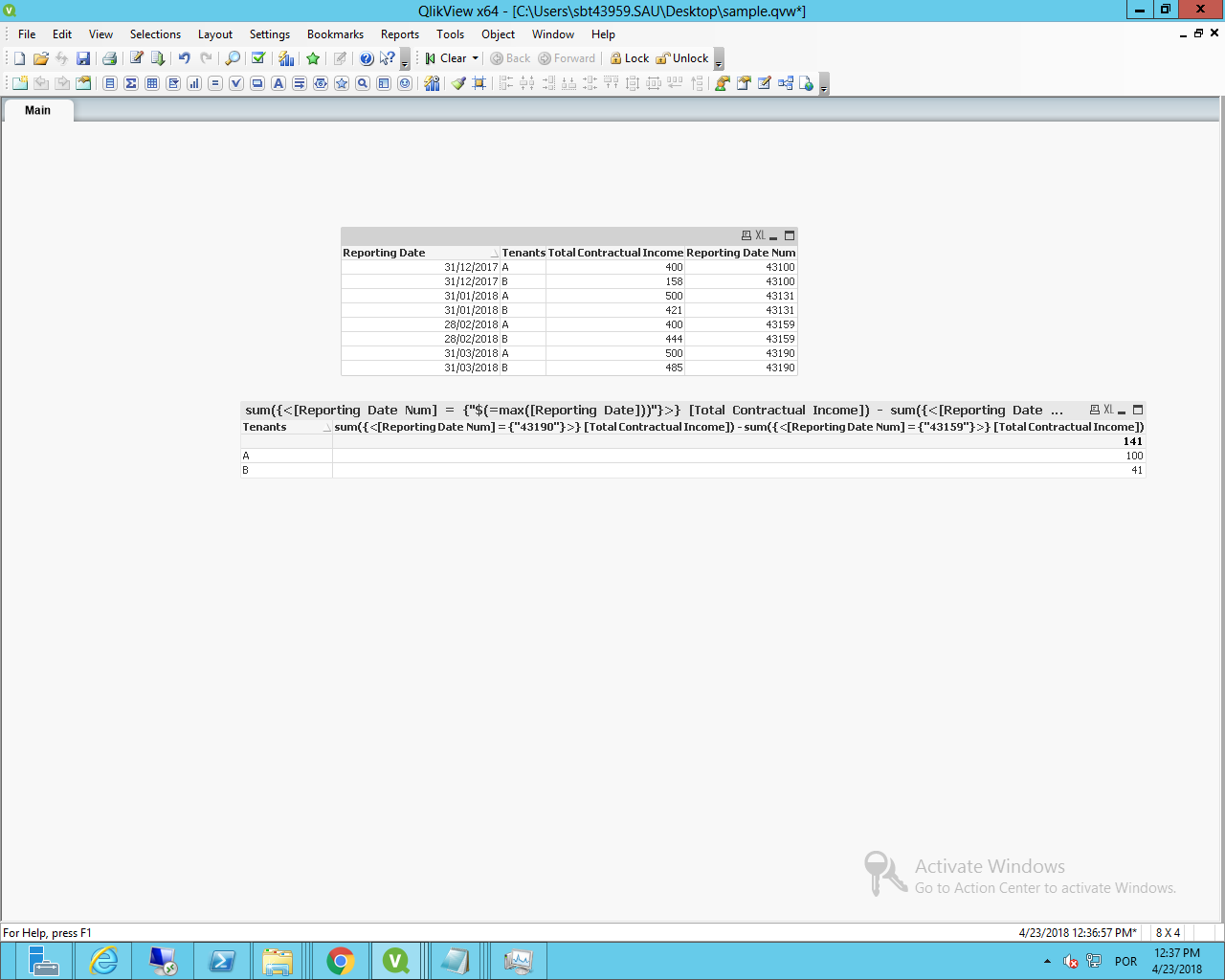Unlock a world of possibilities! Login now and discover the exclusive benefits awaiting you.
- Qlik Community
- :
- All Forums
- :
- Visualization and Usability
- :
- Re: Qlik Sense - Set Analysis, calculate delta for...
- Subscribe to RSS Feed
- Mark Topic as New
- Mark Topic as Read
- Float this Topic for Current User
- Bookmark
- Subscribe
- Mute
- Printer Friendly Page
- Mark as New
- Bookmark
- Subscribe
- Mute
- Subscribe to RSS Feed
- Permalink
- Report Inappropriate Content
Qlik Sense - Set Analysis, calculate delta for two time periods
Hi All,
first of all, I would like to thank everyone that has been / is contributing to this community. It seems like a very lively one and good at that too. I have been trying to answer my question for the past 2 hours, but to no avail.
My data looks like this:
| Reporting Date | Tenants | Total Contractual Income |
|---|---|---|
| 31/03/2018 | A | 500 |
| 28/02/2018 | A | 400 |
| 31/01/2018 | A | 500 |
| 31/12/2017 | A | 400 |
| 31/03/2018 | B | 485 |
| 28/02/2018 | B | 444 |
| 31/01/2018 | B | 421 |
| 31/12/2017 | B | 158 |
I am trying to set up a pivot table which will include the delta between two periods, ideally the most current (31/03/18 and 28/02/2018 or 31/12/2017, alternatively) across both tenants. I have tried the following:
sum({<[Reporting Date.Date] = {"$(=max([Reporting Date.Date]))"}>} [Total Contractual Income]) - sum({<[Reporting Date.Date] = {"$(=max([Reporting Date.Date],2))"}>} [Total Contractual Income])
The result of this is 0, whereas it should not be 0.
Does anybody have an idea why the above formula is not working?
Thanks,
Kai
- Mark as New
- Bookmark
- Subscribe
- Mute
- Subscribe to RSS Feed
- Permalink
- Report Inappropriate Content
Try this
Sum({<[Reporting Date.Date] = {"$(='>=' & Date(AddMonths(Max([Reporting Date.Date]), -1), 'DD/MM/YYYY') & '<=' & Date(Max([Reporting Date.Date]), 'DD/MM/YYYY'))"}>} [Total Contractual Income])
- Mark as New
- Bookmark
- Subscribe
- Mute
- Subscribe to RSS Feed
- Permalink
- Report Inappropriate Content
Hi Kai,
I'm assuming your date field is not being interpreted as a number, instead, it's a string and the set analysis will not work.
With your data, i did:
data:
Load
Date#([Reporting Date],'DD/MM/YYYY') as [Reporting Date],
Num(Date#([Reporting Date],'DD/MM/YYYY')) as [Reporting Date Num],
Tenants,
[Total Contractual Income];
Load * Inline
[
Reporting Date,Tenants,Total Contractual Income
31/03/2018,A,500
28/02/2018,A,400
31/01/2018,A,500
31/12/2017,A,400
31/03/2018,B,485
28/02/2018,B,444
31/01/2018,B,421
31/12/2017,B,158
]
And with your expression: sum({<[Reporting Date Num] = {"$(=max([Reporting Date]))"}>} [Total Contractual Income]) - sum({<[Reporting Date Num] = {"$(=max([Reporting Date],2))"}>} [Total Contractual Income])
I obtained:

Tip: it's much easier to deal with dates in a numeric format instead of the textual one and the example above can be done in Sense, just made it on view because it's the one i have installed.
Felipe.
- Mark as New
- Bookmark
- Subscribe
- Mute
- Subscribe to RSS Feed
- Permalink
- Report Inappropriate Content
Hi Sunny,
thanks a lot for answering so quickly. This formula works in principle on my data. What it does though is adding the two together.
Suppose my total for 31/03/18 is 985 and mu total for 28/02/2018 is 844. Your formula would yield 1,829 as a result. How do I need to modify it in case I wanted to calculate 985 - 844 = 141?
I have tried adjusting it myself, but cannot make it work.
Many thanks,
Kai
- Mark as New
- Bookmark
- Subscribe
- Mute
- Subscribe to RSS Feed
- Permalink
- Report Inappropriate Content
May be this
Sum({<[Reporting Date.Date] = {"$(='>=' & Date(AddMonths(Max([Reporting Date.Date]), -1), 'DD/MM/YYYY') & '<' & Date(MonthStart(Max([Reporting Date.Date])), 'DD/MM/YYYY'))"}>} [Total Contractual Income])
-
Sum({<[Reporting Date.Date] = {"$(='>=' & Date(MonthStart(Max([Reporting Date.Date])), 'DD/MM/YYYY') & '<=' & Date(Max([Reporting Date.Date]), 'DD/MM/YYYY'))"}>} [Total Contractual Income])
- Mark as New
- Bookmark
- Subscribe
- Mute
- Subscribe to RSS Feed
- Permalink
- Report Inappropriate Content
Thanks for your help Sunny_talwar.
if you need a printout from the beginning to a point in the middle of a month, then this goes like this:
Sum({<[Reporting Date.Date] = {"$(='>=' & Date(MonthStart(Max([Reporting Date.Date])), 'DD/MM/YYYY') & '<=' & vToday)"}>} [Total Contractual Income])
where vToday should then be created in the script as vToday = Today();.